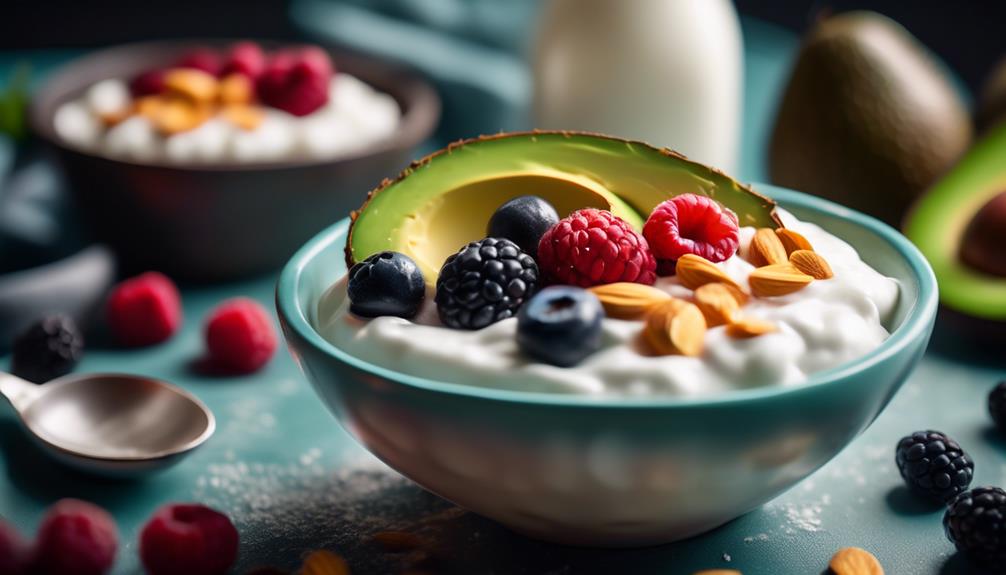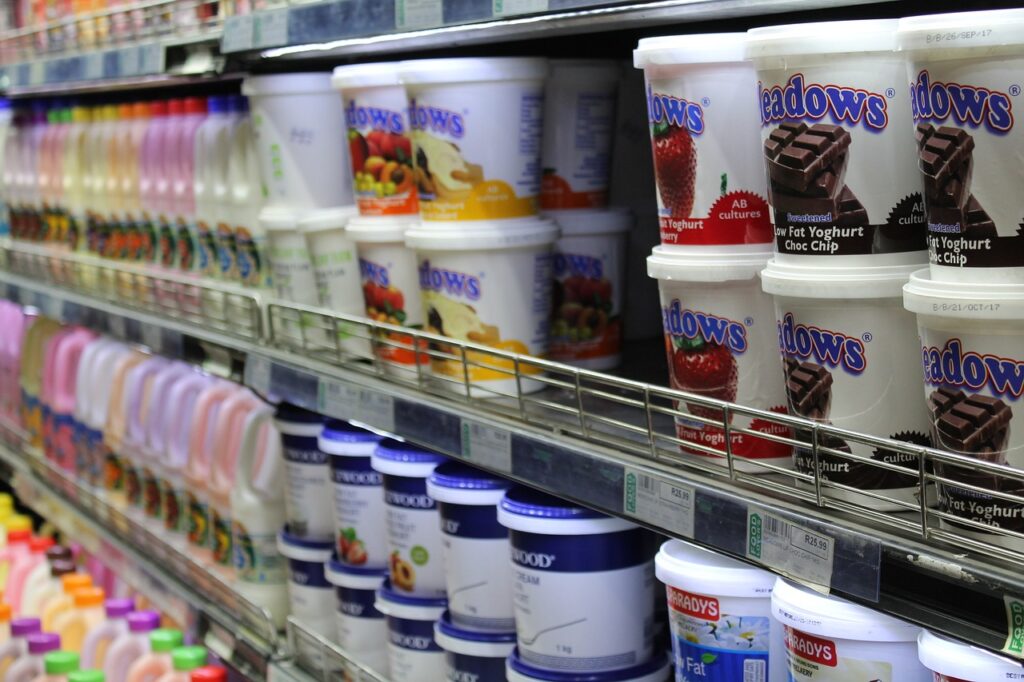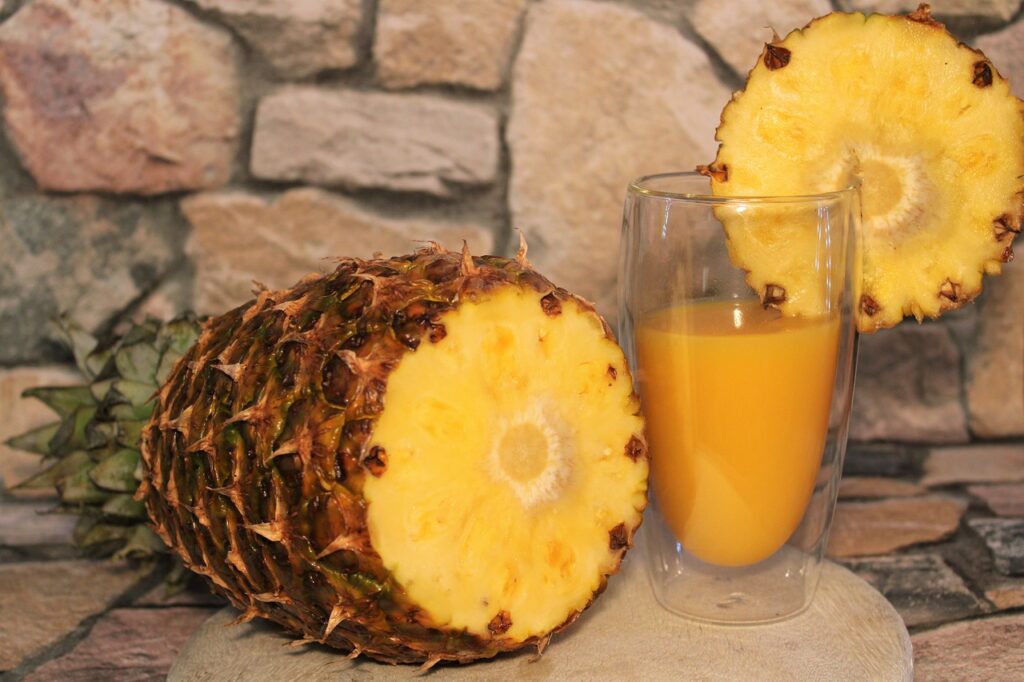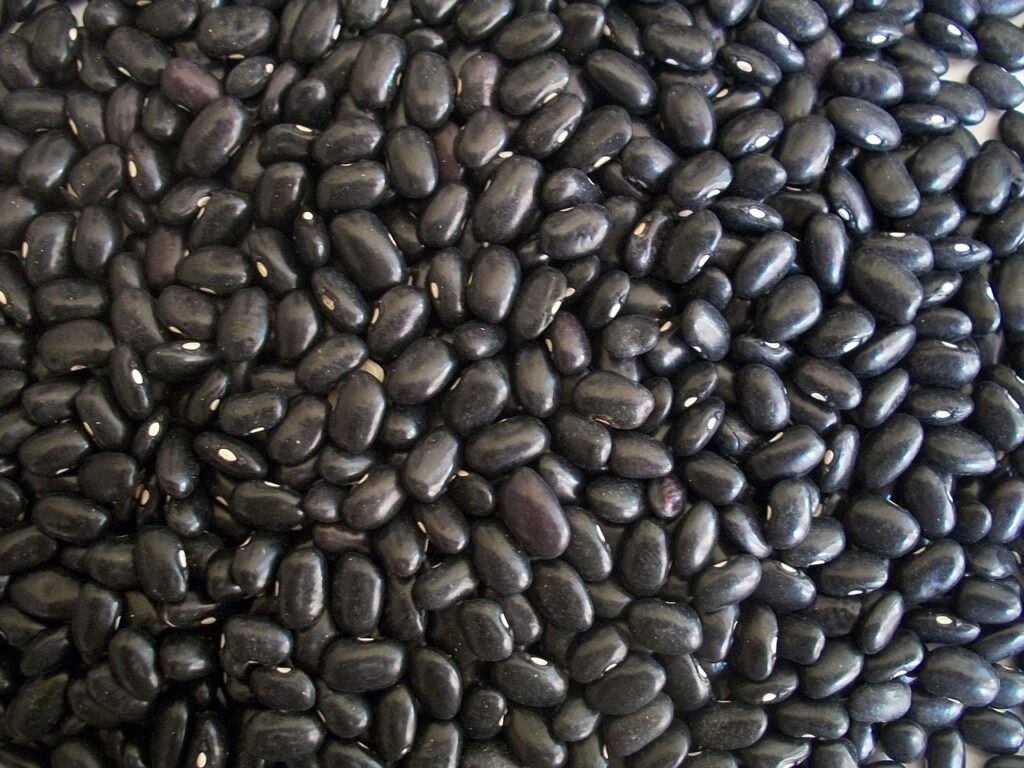Looking to enjoy a delicious, dairy-free yogurt on your keto diet? Look no further than our comprehensive guide on delicious dairy-free keto yogurt alternatives.
Whether you're vegan, lactose intolerant, or simply looking for a healthier option, this guide has got you covered.
From homemade recipes to store-bought options, we'll explore the best plant-based milk alternatives and provide tips on how to make and enjoy your very own dairy-free keto yogurt.
So, if you're ready to elevate your yogurt game without compromising your dietary goals, keep reading to discover the wonderful world of dairy-free keto yogurt alternatives.
Coconut Yogurt Recipe

To make a delicious and dairy-free coconut yogurt at home, follow this simple recipe.
Start by gathering the following ingredients:
- One can of full-fat coconut milk
- One tablespoon of gelatin
- One teaspoon of probiotic powder
Begin by heating the coconut milk in a saucepan over low heat until it reaches a gentle simmer. Sprinkle the gelatin over the coconut milk and whisk until it's fully dissolved.
Remove the mixture from heat and let it cool down to room temperature. Once cooled, add the probiotic powder and mix well.
Transfer the mixture to a glass jar and cover it with a clean cloth or paper towel. Allow it to sit at room temperature for 24 to 48 hours to ferment.
After fermentation, refrigerate the coconut yogurt for at least four hours to thicken. Feel free to experiment with different thickeners or straining methods to adjust the texture according to your preference.
This homemade coconut yogurt isn't only dairy-free but also suitable for those following a keto diet. Enjoy your creamy and probiotic-rich coconut yogurt as it's or customize it with your favorite fruits, nuts, or spices for added flavor.
Dairy-Free Yogurt Brands
If you're looking for dairy-free yogurt options, there are several brands available that cater to different dietary preferences and needs.
Culina's Plain is a recommended brand for simple plant-based yogurt. They offer a creamy and tangy yogurt alternative that's free from dairy and packed with flavor.
CoYo is another popular choice, offering a range of coconut milk-based yogurts, including unsweetened varieties. Their yogurts are rich, smooth, and perfect for those who enjoy the taste of coconut.
If you prefer almond milk-based yogurts, Kite Hill is a great option. They offer unsweetened and plain varieties that are creamy and delicious.
Forager Project is known for their cashew milk-based yogurts, which come in unsweetened and plain options. Their yogurts have a smooth and creamy consistency that's sure to satisfy.
Lastly, Almond Breeze offers almond milk-based yogurts, so be sure to check for unsweetened or low-carb options.
With these dairy-free yogurt brands, you can enjoy delicious yogurt alternatives that are suitable for your dietary needs.
Tips for Enjoying Keto Yogurt

To enhance the flavor of your dairy-free keto yogurt, try adding keto-friendly toppings like almonds, chia seeds, shredded coconut, or crushed nuts. These toppings not only provide extra taste but also add texture and nutritional value to your yogurt.
Additionally, using portion control tips such as layering your yogurt with keto-friendly granola, nuts, or seeds can help you create a satisfying and well-balanced parfait.
Toppings for Extra Flavor
Enhance the flavor of your keto yogurt with a variety of delicious and nutritious toppings. Here are some ideas to take your dairy-free keto yogurt to the next level:
- Keto-friendly toppings: Sprinkle your yogurt with almonds, chia seeds, shredded coconut, or crushed nuts to add crunch and texture.
- Berries for natural sweetness: Add a handful of berries like strawberries, blueberries, or raspberries to your yogurt for a burst of natural sweetness and a dose of antioxidants.
- Healthy fats: Boost the satiety and richness of your yogurt by incorporating healthy fats like MCT oil, almond butter, or chia seeds.
- Parfait perfection: Create a parfait by layering your yogurt with keto-friendly granola, nuts, or seeds. This adds variety and creates a satisfying and visually appealing snack or dessert.
Portion Control Tips
To fully enjoy your dairy-free keto yogurt while maintaining portion control, it's important to implement some helpful tips.
First, measure out your serving sizes to avoid overeating. Typically, 1/2 cup to 1 cup is a good portion for keto yogurt.
Be mindful of added toppings and mix-ins, as they can quickly increase the overall calorie and carb content of your yogurt.
Enjoy your keto yogurt as a balanced part of your meal or snack by pairing it with other low-carb, high-fiber foods like nuts or seeds.
Avoid eating directly from the container to prevent mindless consumption and to better gauge portion sizes.
Consider using smaller bowls or cups for your yogurt to help with portion control and to make your serving feel more satisfying.
Storing Keto Yogurt
When it comes to storing your keto yogurt, there are a few important points to keep in mind.
First, make sure to use airtight containers to maintain freshness and prevent spoilage.
Secondly, store your yogurt in the refrigerator at the recommended temperature to ensure its quality.
Lastly, be mindful of the length of storage, checking the expiration date for store-bought yogurt and consuming homemade yogurt within a week for the best taste and texture.
Proper Container for Storage
For optimal freshness, store your keto yogurt in airtight glass containers. Glass containers help maintain the yogurt's flavor and texture while keeping it free from external odors and contaminants. However, if glass isn't an option for convenience and portability, choose BPA-free, plastic containers instead.
Here are a few tips to consider when selecting a proper container for storage:
- Ensure the container is clean and dry before transferring the yogurt to prevent any potential contamination.
- If you prefer portioned servings, consider using single-serve containers for easy grab-and-go options.
- Label the containers with the date of preparation to track freshness and consume within the recommended timeframe.
Refrigeration Temperature Guidelines
Maintaining the proper refrigeration temperature is crucial for storing your dairy-free keto yogurt and preserving its freshness and quality. To keep your yogurt at its best, store it at a temperature of 40°F (4°C) or below. This helps to prevent spoilage and ensures the yogurt remains safe to consume.
It's important to place the yogurt in the coldest part of your refrigerator, such as the back or lower shelves, to avoid temperature fluctuations. Be sure to check the expiration date and consume the yogurt before it exceeds the recommended storage duration.
Additionally, always seal the yogurt container tightly to prevent exposure to air and maintain its freshness.
Length of Yogurt Storage
To ensure the longevity and quality of your dairy-free keto yogurt, it's essential to understand the length of yogurt storage. Follow these guidelines to maintain the freshness of your homemade keto coconut yogurt:
- Refrigeration: Store your dairy-free yogurt in a sealed container in the refrigerator. It can typically be kept for 7-10 days, but always check for any signs of spoilage before consuming.
- Freezing: For longer storage, consider freezing your yogurt in airtight containers. It can be frozen for up to 1-2 months. When ready to consume, thaw the frozen yogurt in the refrigerator and stir well to restore its consistency.
Remember to consult the specific storage recommendations provided by your yogurt recipe or store-bought product. By utilizing these storage methods, you can enjoy your homemade dairy-free keto yogurt for longer periods without compromising its quality.
Where to Buy Dairy-Free Keto Yogurt
You can easily find dairy-free keto yogurt by exploring various purchasing options. Online retailers such as Amazon, Thrive Market, and iHerb offer a wide range of dairy-free keto yogurt options. These platforms allow you to browse through different brands and flavors, read customer reviews, and have the products conveniently delivered to your doorstep.
Health food stores and co-ops are also great places to look for dairy-free keto yogurt alternatives. These specialty stores often carry a variety of brands that cater to different dietary needs. The dairy or health food section of your local grocery store may also have dairy-free keto yogurt options available.
If you prefer to support local businesses and artisanal products, consider checking out farmer's markets in your area. Some farmer's markets offer homemade dairy-free yogurt made with keto-friendly ingredients. This could be a great way to try unique flavors and support small-scale producers.
Lastly, some dairy-free keto yogurt brands may offer direct purchase options through their websites. This allows you to buy directly from the brand, ensuring the freshest products and possibly even exclusive deals.
Flavor Options for Dairy-Free Keto Yogurt

For a delectable twist on your dairy-free keto yogurt, indulge in an array of enticing flavors such as vanilla, berry, chocolate, or matcha. Experimenting with different flavors can add excitement to your low-carb, keto-friendly yogurt while keeping it dairy-free.
Here are some options to consider:
- Natural sweeteners: Enhance the flavor of your dairy-free keto yogurt by adding natural sweeteners like stevia, erythritol, or monk fruit. These alternatives can provide a touch of sweetness without adding extra carbs.
- Savory flavors: Don't limit yourself to just sweet options. Get creative by incorporating herbs, spices, or even a hint of citrus into your dairy-free keto yogurt. This can give your yogurt a unique and savory twist.
To further elevate your dairy-free keto yogurt experience, try these additional tips:
- Toppings: Add some crunch and texture by sprinkling nuts, seeds, or low-carb granola over your yogurt. These additions can provide extra flavor and a satisfying crunch.
- Extracts: Customize the flavor profile of your yogurt by adding extracts like almond, coconut, or mint. These extracts can give your dairy-free keto yogurt a refreshing and aromatic twist.
With the right combination of flavors and toppings, you can enjoy a creamy, dairy-free keto yogurt that satisfies your taste buds while staying true to your low-carb lifestyle.
How to Make Keto Yogurt
To make keto yogurt, start by choosing a non-dairy, low-carb alternative like coconut milk or almond milk as the base.
Then, experiment with different thickening agents like gelatin to achieve your desired consistency.
Incorporate probiotic powder or live organism yogurt to facilitate fermentation and boost gut health.
Adjust the sweetness using keto-friendly sweeteners and explore various flavorings like fruits, nuts, or spices to customize the taste.
With these ingredients and steps, you can create your perfect homemade keto-friendly yogurt.
Ingredients for Keto Yogurt
To make keto yogurt, you can replace traditional dairy ingredients with non-dairy low-carb alternatives such as coconut milk, almond milk, or cashew milk. These plant-based milk alternatives aren't only low in carbs but also provide a creamy and rich base for your yogurt recipe.
Here are some important points to consider when choosing the ingredients for your keto yogurt:
- Use thick and full-fat coconut milk or homemade coconut milk as a base for your yogurt. It will give your yogurt a creamy texture and a subtle coconut flavor.
- Instead of using dairy-based yogurt as a starter, you can use probiotic capsules or live organism cashew yogurt to ferment the coconut milk and create the tangy flavor of traditional yogurt.
- You can add flavorings and coloring to enhance the taste and appearance of your keto yogurt. Options include vanilla extract, cocoa powder, or fruit puree.
Step-by-Step Process
To make keto yogurt, you'll begin by selecting a non-dairy, low-carb milk alternative such as coconut milk, almond milk, or cashew milk as the base.
Pour the milk into a pot and gently heat it until warm, not hot.
Slowly add gelatin powder to the warm milk, stirring well to incorporate it as a thickening agent.
Next, sprinkle probiotic powder into the mixture, ensuring it's evenly distributed.
Cover the pot and let the mixture ferment overnight at room temperature, allowing the probiotics to culture the yogurt.
These steps provide a basic guideline for creating a delicious dairy-free keto yogurt at home.
Tips for Perfect Yogurt
For perfect keto yogurt, consider using full-fat canned coconut milk for a thick and creamy consistency. Coconut milk is an excellent dairy-free alternative that provides a rich and creamy base for your yogurt.
To ensure that your yogurt is packed with beneficial bacteria, use probiotics in capsule or powder form, avoiding those in pill form. These probiotics will help to ferment the coconut milk and create a tangy flavor.
Additionally, you can experiment with different thickeners or straining methods to adjust the thickness and texture of your yogurt. Adding healthy fats like MCT oil, almond butter, or chia seeds can enhance the richness of your yogurt.
Ingredients for Keto Yogurt
When creating keto yogurt, traditional dairy ingredients are replaced with non-dairy low-carb alternatives such as coconut milk, almond milk, and cashew milk. These plant-based milk alternatives serve as the base for dairy-free keto yogurt.
When making homemade coconut milk yogurt, additional ingredients like gelatin powder and probiotic powder are essential. Gelatin powder helps thicken the yogurt and give it a creamy texture, while probiotic powder introduces beneficial bacteria for gut health.
It's important to note that different brands of coconut milk and probiotics can yield varying nutritional content and flavors. Therefore, it's recommended to experiment with different brands to find the ones that suit your taste preferences and dietary needs.
To further customize the flavor and nutritional profile of your keto yogurt, you can add keto-friendly sweeteners like stevia or erythritol, as well as fruits, nuts, and spices. These additions can enhance the taste and add variety to your dairy-free keto yogurt.
Tips for Making Keto Yogurt

If you're looking to create a delicious and creamy keto yogurt without dairy, there are a few tips that can help ensure success.
- Use full-fat canned coconut milk for a thick and creamy yogurt. Coconut milk is a great dairy-free alternative that provides a rich and creamy texture to your yogurt. Opting for the full-fat version will give you a smoother consistency and a more satisfying taste.
- Experiment with different flavorings such as fruits, nuts, or spices to enhance the taste. Adding natural flavorings to your yogurt can make it more enjoyable and help satisfy your cravings. Try adding berries, vanilla extract, cinnamon, or unsweetened cocoa powder for a delicious twist.
- Add keto-friendly toppings like almonds, chia seeds, shredded coconut, or crushed nuts for added texture and nutrition. Toppings not only add a crunch and variety to your yogurt, but they also provide additional nutrients and healthy fats that are beneficial for your keto diet.
- Choose probiotics in capsule or powder form, avoiding those in pill form and containing FOS (fructooligosaccharides). Probiotics are essential for gut health and can help improve digestion. Look for probiotics specifically designed for dairy-free yogurt making to ensure the best results.
- Experiment with different methods to thicken the yogurt without guar gum, such as using coconut meat or coconut butter. Guar gum is often used in commercial yogurts to thicken them, but it may not be suitable for a keto diet. Instead, try using coconut meat or coconut butter to achieve a thick and creamy consistency.
Serving Suggestions for Keto Yogurt
To enhance the texture and flavor of your keto yogurt, consider incorporating keto-friendly toppings and fresh berries. Adding these extras not only adds variety and excitement to your dairy-free keto yogurt alternatives but also provides additional nutritional benefits.
Some keto-friendly toppings you can try are almonds, chia seeds, or shredded coconut. These toppings add a satisfying crunch and extra flavor to your yogurt.
Fresh berries are another great addition as they provide natural sweetness and antioxidants. You can choose from options like strawberries, blueberries, or raspberries to add a burst of color and freshness to your keto yogurt.
To boost the nutritional value of your yogurt, consider adding healthy fats such as MCT oil or almond butter. These fats not only enhance the creaminess of the yogurt but also provide essential nutrients.
Another serving suggestion is to create a yogurt parfait by layering your keto yogurt with keto-friendly granola, nuts, or seeds. This adds a delightful texture and makes your yogurt more filling.
Lastly, don't be afraid to experiment with different flavorings like fruits, nuts, or spices to customize the taste of your keto yogurt to your preference.
Enjoy the deliciousness of your dairy-free keto yogurt alternatives with these serving suggestions!
Conclusion
In conclusion, Delicious Dairy-Free Keto Yogurt Alternatives: A How-To Guide offers a wealth of information and resources for those seeking dairy-free options on a keto diet.
Whether you choose to make your own yogurt at home or explore different brands available in stores, there are plenty of delicious options to satisfy your cravings.
Remember, the yogurt world is your oyster, so dive in and enjoy the creamy goodness without compromising your dietary goals.







